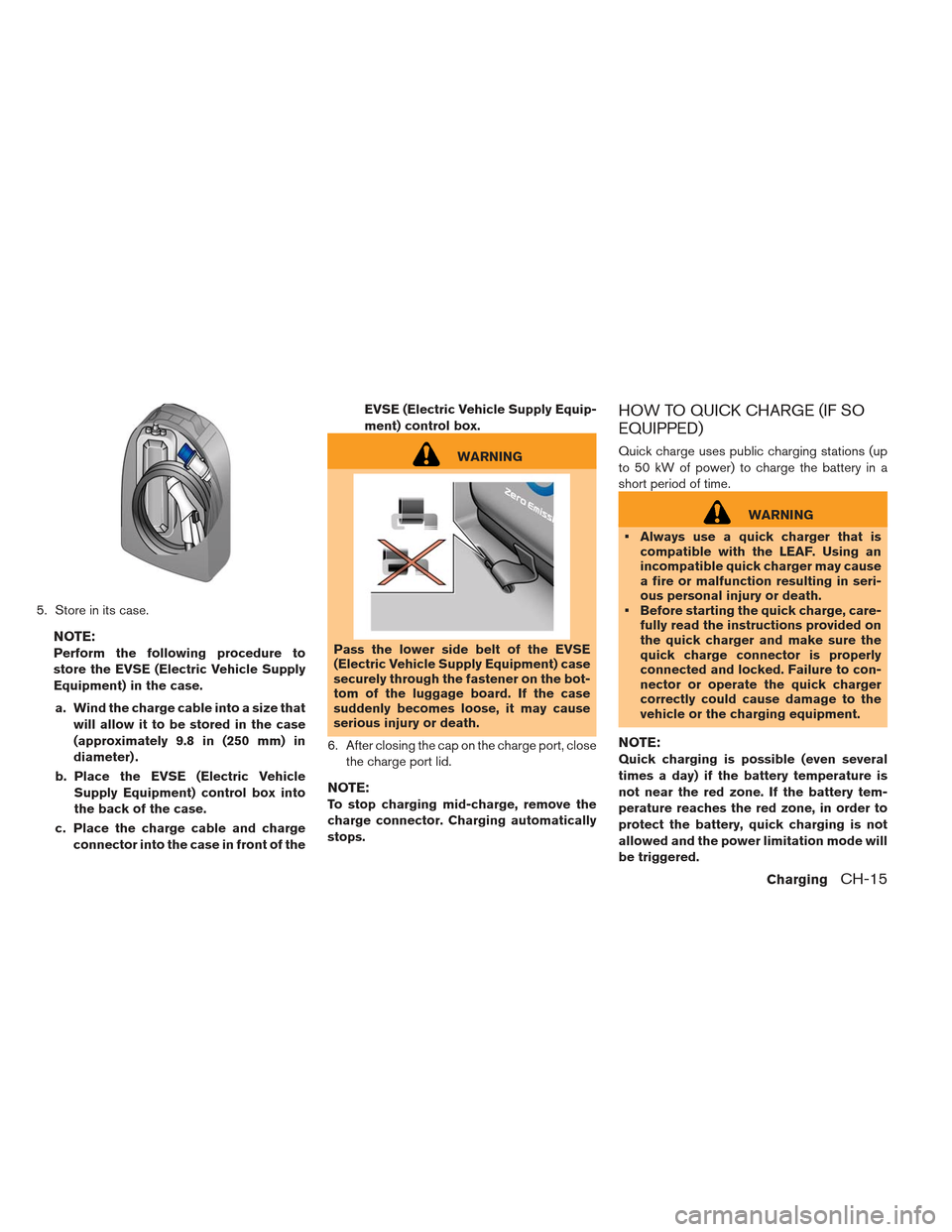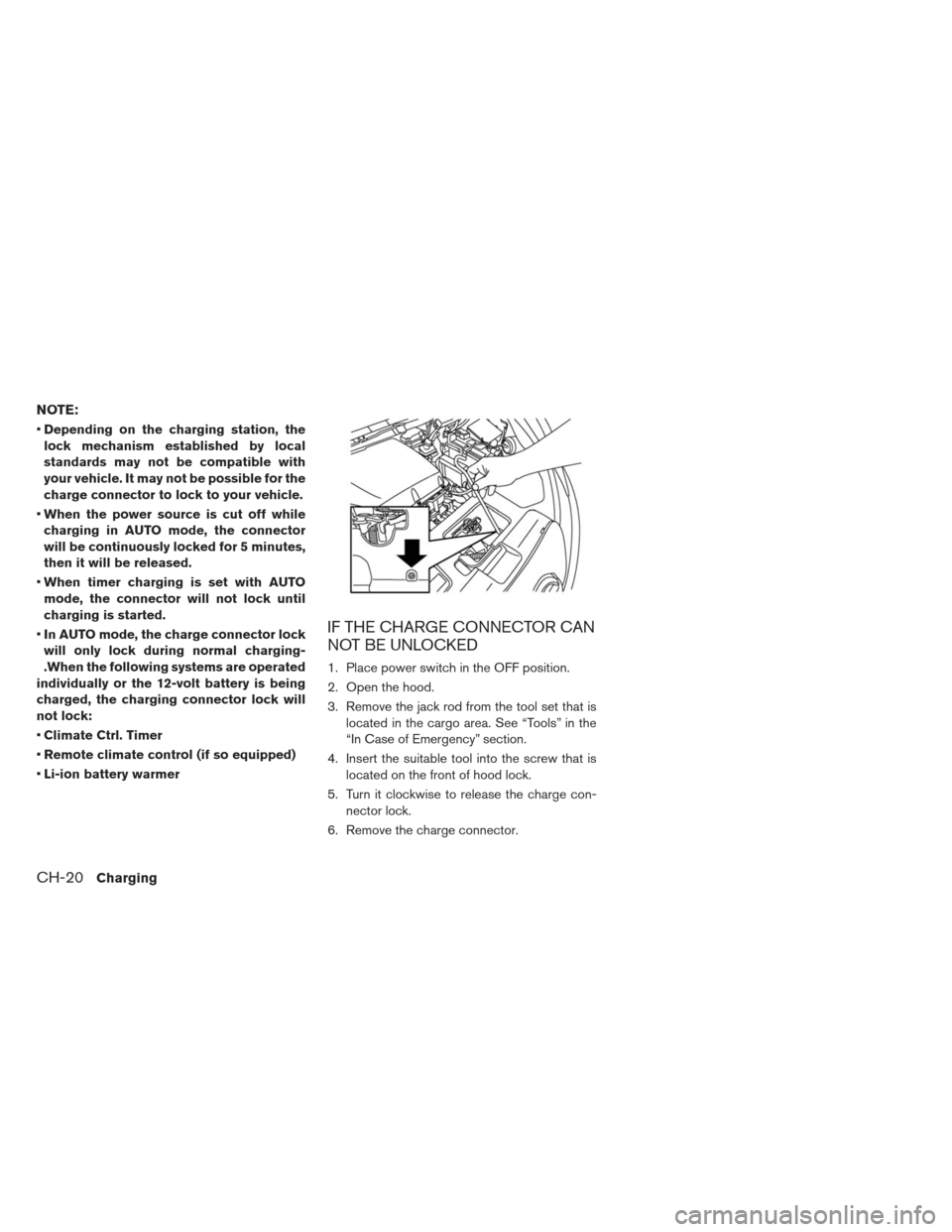Page 63 of 402
8. Connect the charge connector to the chargeport. If it is connected normally, a beep will
sound once.
9. If charging has started, or if the Li-ion battery is waiting for charging timer, a beep will sound
twice and the charging status indicator light
display will change. See �Charging status in-
dicator light�. 10. When recharging outside such as in your
drive way, use a commercially available pad-
lock attached in position
�Ato prevent theft. To stop trickle charge:
1. Ensure that the charge connector lock is not
engaged. For more information, see “Charge
connector lock switch” in this section.
2. Press the button on the charge connector, release the lock and remove the charge con-
nector from the charge port.
3. Attach the safety cap to the EVSE (Electric Vehicle Supply Equipment) .
4. Remove the electrical plug from the AC 110 - 120 volt, 15A dedicated electrical outlet.
CH-14Charging
Page 64 of 402

5. Store in its case.
NOTE:
Perform the following procedure to
store the EVSE (Electric Vehicle Supply
Equipment) in the case.a. Wind the charge cable into a size that will allow it to be stored in the case
(approximately 9.8 in (250 mm) in
diameter) .
b. Place the EVSE (Electric Vehicle Supply Equipment) control box into
the back of the case.
c. Place the charge cable and charge connector into the case in front of the EVSE (Electric Vehicle Supply Equip-
ment) control box.
WARNING
Pass the lower side belt of the EVSE
(Electric Vehicle Supply Equipment) case
securely through the fastener on the bot-
tom of the luggage board. If the case
suddenly becomes loose, it may cause
serious injury or death.
6. After closing the cap on the charge port, close the charge port lid.
NOTE:
To stop charging mid-charge, remove the
charge connector. Charging automatically
stops.
HOW TO QUICK CHARGE (IF SO
EQUIPPED)
Quick charge uses public charging stations (up
to 50 kW of power) to charge the battery in a
short period of time.
WARNING
Always use a quick charger that is compatible with the LEAF. Using an
incompatible quick charger may cause
a fire or malfunction resulting in seri-
ous personal injury or death.
Before starting the quick charge, care- fully read the instructions provided on
the quick charger and make sure the
quick charge connector is properly
connected and locked. Failure to con-
nector or operate the quick charger
correctly could cause damage to the
vehicle or the charging equipment.
NOTE:
Quick charging is possible (even several
times a day) if the battery temperature is
not near the red zone. If the battery tem-
perature reaches the red zone, in order to
protect the battery, quick charging is not
allowed and the power limitation mode will
be triggered.
ChargingCH-15
Page 65 of 402
To start charging:
1. Push the P (Park) position switch to place thevehicle in the P (Park) position and apply the
parking brake.
2. When charging the Li-ion battery, place the power switch in the OFF position. When the
power switch is in the ON position, the Li-ion
battery will not start charging.
3. Open the charge port lid and charge port cap. See �Charge port lid� and�Charge port cap�
in the �Pre-driving checks and adjustments�
section. 4. Align�1with the groove of the charge port
and insert the charge connector.
CAUTION
Be sure to insert the charge connector
straight into the quick charge port right
up to the base. Failure to do so may
result in the Li-ion battery not charging
or could cause damage to the charging
equipment.
CH-16Charging
Page 66 of 402

5. Grasp the lock lever and lock the chargeconnector.
6. Follow the instructions on the quick charge equipment to start charging. When the equip-
ment is properly installed and ready to charge
a beep sounds twice and the charging status
indicator light will change. See �Charge sta-
tus indicator light� in the�Pre-driving checks
and adjustments� section.
Charging ends in the following situations.
When charging is complete
When charging time has exceeded 60 minutes
When the possible charge time set for the quick charger is exceeded
NOTE:
Charging may automatically stop even if it
is not completed.
If charging stops mid-charge, you can re-
start charging by pressing the start button
on the quick charger again.
The charge connector is locked to the
charge port during charging and cannot
be disconnected. Follow the instructions
on the quick charge equipment to stop
charging. Confirm charging is stopped by
looking at the indicators on the dash. The
charge connector can be disconnected
from the vehicle when charging is
stopped.
When quick charging, the Li-ion battery
charging rate is slower as the percentage
available battery charge available in-
creases. To finish charging:
1. Confirm charging is stopped by looking at the
indicators on the dash. The charge connector
can be disconnected from the vehicle when
charging is stopped.
2. Unlock the charge connector and remove from the vehicle and properly store it.
3. Close the quick charge port cap.
4. Shut the charge port lid.
ChargingCH-17
Page 69 of 402

NOTE:
Depending on the charging station, the
lock mechanism established by local
standards may not be compatible with
your vehicle. It may not be possible for the
charge connector to lock to your vehicle.
When the power source is cut off while
charging in AUTO mode, the connector
will be continuously locked for 5 minutes,
then it will be released.
When timer charging is set with AUTO
mode, the connector will not lock until
charging is started.
In AUTO mode, the charge connector lock
will only lock during normal charging-
.When the following systems are operated
individually or the 12-volt battery is being
charged, the charging connector lock will
not lock:
Climate Ctrl. Timer
Remote climate control (if so equipped)
Li-ion battery warmer
IF THE CHARGE CONNECTOR CAN
NOT BE UNLOCKED
1. Place power switch in the OFF position.
2. Open the hood.
3. Remove the jack rod from the tool set that is
located in the cargo area. See “Tools” in the
“In Case of Emergency” section.
4. Insert the suitable tool into the screw that is located on the front of hood lock.
5. Turn it clockwise to release the charge con- nector lock.
6. Remove the charge connector.
CH-20Charging
Page 70 of 402
CHARGING TIMER
Use charging timer to schedule when the Li-ion
battery charges. The vehicle automatically begins
charging at the scheduled times when the charge
connector is connected to the vehicle. The timers
do not need to be reset each time the Li-ion
battery needs charging.
With navigation system
The charging timer can save two timer settings
that include the charging start time and end time.
The charging timer can be applied to one of the
timer settings for each day of the week.1. Push the Zero Emission button
and
touch [Charging Timer]. 2. Touch [Set Timer 1] or [Set Timer 2]. The
following procedure explains Timer 1 setting.
CHARGING METHODS
ChargingCH-21
Page 71 of 402
![NISSAN LEAF 2013 1.G Owners Manual 3. Enter the Li-ion battery charge start time.Touch [% Charge] to change the amount of
charging. Touch [END Time] to change the
time to stop charging.
NOTE:
Charging timer is performed according to
th NISSAN LEAF 2013 1.G Owners Manual 3. Enter the Li-ion battery charge start time.Touch [% Charge] to change the amount of
charging. Touch [END Time] to change the
time to stop charging.
NOTE:
Charging timer is performed according to
th](/manual-img/5/325/w960_325-70.png)
3. Enter the Li-ion battery charge start time.Touch [% Charge] to change the amount of
charging. Touch [END Time] to change the
time to stop charging.
NOTE:
Charging timer is performed according to
the current time setting on the bottom
right of the display. When setting the
charging timer function, be sure to check
that the current time displayed is correct.
In the default setting, [100% Charge
(Maximizes Driving Range)] is selected.
This is called long distance mode. To ex-
tend the life span of the Li-ion battery, use
long life mode by selecting [80% Charge
(Improves Battery Longevity)]. See �Long
life charge�. 4. Touch [Assign Days] to set the charging timer
for different days of the week. Either Timer 1
or Timer 2 or OFF can be set for each day of
the week. Touch [OK] when the settings are
complete.
5. Touch [OK] when the settings are complete and a settings confirmation screen is
displayed.
NOTE:
If OFF is selected for a day of the week,
the charging timer will not operate on
that day. The system will wait until the
next charging timer set to perform
charging. 6. Touch [Yes] if the settings shown on the
screen are correct.
CH-22Charging
Page 72 of 402
![NISSAN LEAF 2013 1.G Owners Manual 7. The [Timer 1] indicator illuminates after thecharging timer is set. Use the same procedure
to set the Timer 2 setting.
8. Place the power switch in the OFF position, and then connect the charge con NISSAN LEAF 2013 1.G Owners Manual 7. The [Timer 1] indicator illuminates after thecharging timer is set. Use the same procedure
to set the Timer 2 setting.
8. Place the power switch in the OFF position, and then connect the charge con](/manual-img/5/325/w960_325-71.png)
7. The [Timer 1] indicator illuminates after thecharging timer is set. Use the same procedure
to set the Timer 2 setting.
8. Place the power switch in the OFF position, and then connect the charge connector to the
vehicle.
NOTE:
Always place the power switch in the OFF
position after setting the charging timers.
When the power switch is in the ON posi-
tion, the Li-ion battery will not start charg-
ing.
The Li-ion battery may not be charged to
the expected level if the charging timer start time and end time are set so there is
not enough time to charge the Li-ion bat-
tery.
When either the charge start time or
charge end time is set, the charging timer
function is activated.
When only the charging timer end time is
set, the system automatically determines
when to begin charging based on the Li-
ion battery charge level. The Li-ion battery
may not be charged to the expected level
in the following conditions: – The Li-ion battery is charged in cold weather.
– The charge connector is connected to the vehicle too close to the scheduled
charging end time.
When only the charging timer end time is
set, the system automatically stops charg-
ing when the Li-ion battery charges to the
selected level. Charging may stop before
the scheduled end time.
Touch [Timer 1] or [Timer 2] to turn off the
charging timer function. Touch [Yes] if the
settings shown on the screen are correct.
After this operation has been performed,
the indicator disappears and the charging timer function is turned off. The start and
stop time settings are not deleted, even if
the charging timer function is turned off.
If charging timer and the Climate Ctrl.
Timer are operating at the same time due
to an overlap of the timer settings, you can
prioritize which function receives electri-
cal power first. See LEAF Navigation Sys-
tem Owner’s Manual.
When charging is set as the first priority,
the Climate Ctrl. Timer does not start until
10 segments of the Li-ion battery avail-
able charge gauge are illuminated.
When the climate control is set as the first
priority, the climate control system will be
turned on as scheduled by the Climate
Ctrl. Timer regardless of the remaining
battery energy.
Even when the climate control is set as
the first priority, the climate control sys-
tem will be turned off when the electric
demands of the climate control system is
more than can be provided to the Li-ion
battery for charging.
Some charging stations used to perform
normal charge are equipped with timer
functions. If the charger timer function
ChargingCH-23